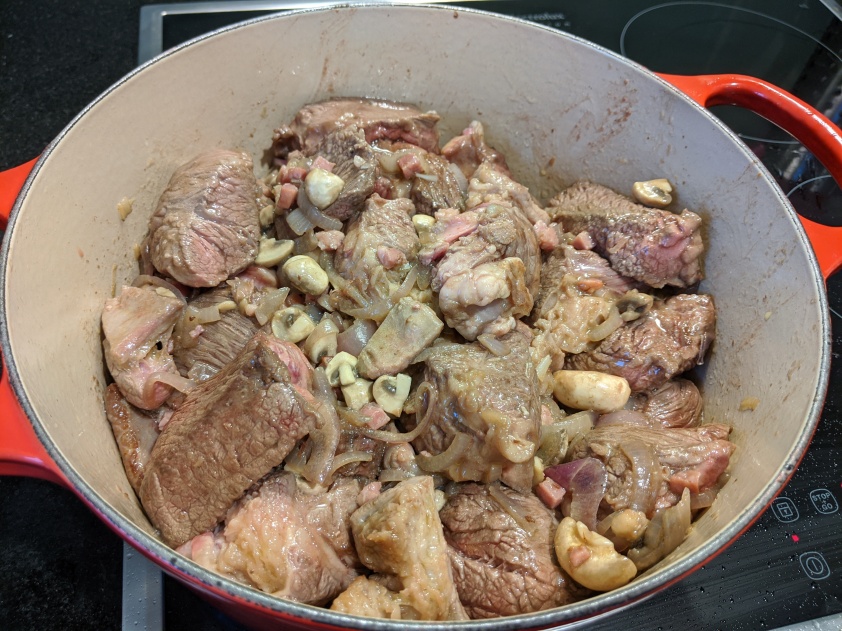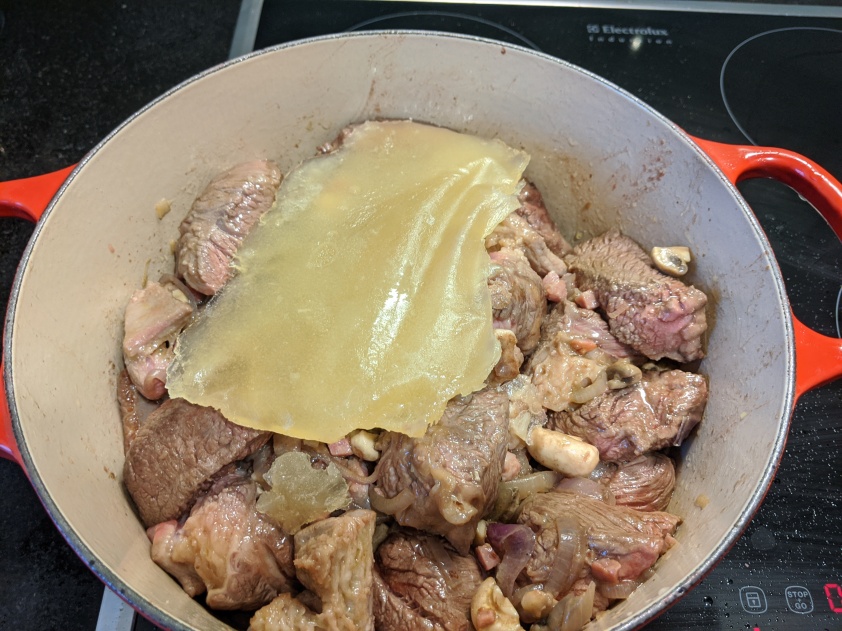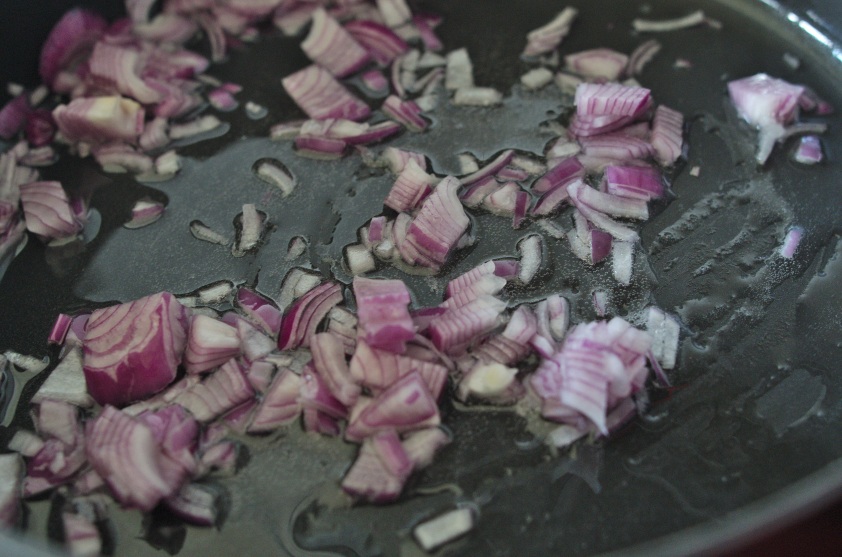English version interleaved in italics
Le cuiseur sous-vide duquel j’ai déjà parlé à propos de steak fait à présent partie, si ce n’est du quotidien, du moins du multimensuel – on lui a adjoint un bidule-à-faire-du-vide-un-peu-plus-correct qui n’a peut-être pas d’autre avantage que de satisfaire nos geeks intérieurs, mais c’est déjà beaucoup 🙂
The sous-vide cooker that I already discussed when talking about steak is now maybe not an everyday utensil, but a several-times-a-month one – we added to it a thingy-to-make-better-vacuum that may not have much more benefits than to satisfy our inner geeks, but it’s something 🙂
Les viandes rouges (bœuf, agneau, canard) y gagnent nettement ; pour le poulet c’était jusqu’ici un peu plus discutable. Et puis je suis tombée sur The Food Lab’s Guide to Crispy Sous-Vide Chicken Thighs (qu’on pourrait traduire par Guide Food Lab pour des hauts de cuisse sous-vide croustillants) qui m’a donné envie de faire quelques essais.
Red meats (beef, lamb, duck) show clear improvements; for chicken, it was so far a bit more disputable. And then, I stumbled upon The Food Lab’s Guide to Crispy Sous-Vide Chicken Thighs that made me want to do a few more tries.
J’avoue, j’étais un peu sceptique à la base, parce que la procédure en question fait cuire le poulet, le refroidit dans un bain glacé, et termine la cuisson plus tard. Et il est une chose que je n’aime vraiment, vraiment pas, c’est le goût du poulet réchauffé. J’ai donc posé la question qui fâche sur le guide susnommé, et on m’a répondu que le goût du poulet réchauffé, c’était essentiellement un problème d’oxydation de la graisse de poulet, ce qui posait nettement moins de problème avec une cuisson sous-vide, par définition. Donc, ce soir, on a mangé du poulet réchauffé 😉
I’ll admit I was a bit skeptical, because the procedure in that guide makes you cook the chicken, cool it in an ice-water bath, and finishes the cooking later. And there’s one thing I really, really don’t like: reheated chicken taste. So I asked exactly that question in the comments of the aforementioned guide, and I got as an answer that what made that taste was a matter of chicken fat oxydation, which is far less of an issue with sous-vide cooking, by definition. So, this evening, we had reheated chicken 😉

Le guide indique des températures variant de 66°C à 74°C pour la cuisson du poulet ; comme je suis paranoïaque, j’ai opté pour le 74°C. On commence par faire préchauffer l’eau, donc.
The guide gives temperatures between 66°C and 74°C for chicken; since I’m paranoid, I chose 74°C. So let’s first heat some water.

Le poulet est salépoivré avant de le ranger dans des petits sacs.
Season the chicken with salt and pepper before putting it in small bags.

Bon, OK, des grands sacs, parce qu’on n’en a pas vraiment de petits. La bête là aspire l’air du sac et le scelle, c’est vachement pratique. On l’utilise aussi pour congeler des trucs, et on voit une différence sur la quantité de givre qui se dépose, en particulier. C’est pas indispensable, mais c’est pratique.
Fine, let’s say large bags, because we don’t really have small ones. The thing here sucks the air out of the bag and seals it, it’s quite convenient. We also use it when we freeze stuff, and there’s a real difference on the amount of ice that ends up on whatever we freeze. It’s not indispensable, but it’s convenient.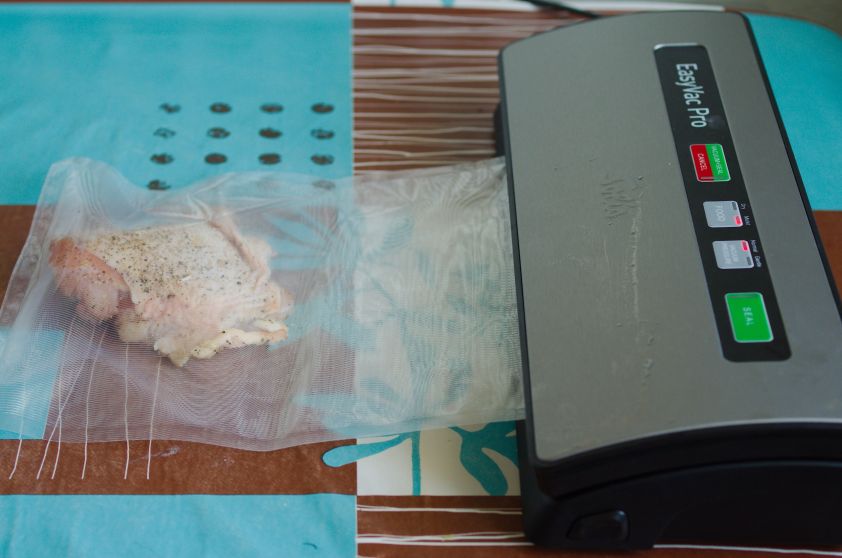
Une fois l’eau arrivée à température, on y met le poulet (l’eau refroidit un peu, forcément, le poulet est plus froid, la thermodynamique a ses limites…)
Once the water is at the right temperature, we add the chicken (the water cools down a bit, obviously, chicken being colder and thermodynamics being what they are).

Et on laisse cuire dans le bain d’eau chaude pendant, d’après le guide, 1 à 4 heures – j’ai mis 1h30. Une fois l’heure et demie écoulée, le truc qui fait frémir : on refroidit le poulet. Violemment : on prend les sachets sous-vide, et on les plonge dans un bain d’eau glacée. Enfin du moins un bain d’eau avec des glaçons et un réfrigérant qui se trouvait se promener par là. Une fois le poulet refroidi, il peut s’en aller au frigo jusqu’à l’heure de dîner.
Let it cook in the warm water bath for, according to the guide, 1 to 4 hours – I set it for 1h30. After that hour and a half, the thing that makes me shiver : you cool down the chicken. Violently: you take the sous-vide bags, and you drop them in an ice water bath. Well, a water bath with a few ice cubes and an ice pack that happened to be there. Once the chicken is cooled down, it can go to the fridge until dinner time.

Arrive l’heure du dîner. Mes haricots verts sont déjà à l’eau, et donc je finis le poulet. Ouverture des sacs, le poulet a rendu un peu de gelée, que je garde pour la sauce. Une fois la gelée récupérée de manière plus ou moins approximative, on tapote le poulet avec du Sopalin histoire qu’il soit sec au moment de le mettre dans la poêle.
Now it’s time for dinner. My green beans are already boiling, and so it’s time to finish preparing the chicken. Opening of the bags, the chicken rendered a bit of gelled liquid, that I keep for the sauce. Once this is scraped (more or less approximately), I patted the chicken with some paper towel so that it’s as dry as possible when putting it in the pan.

Et zou, dans une poêle à feu moyen-haut avec un peu d’huile au fond. On laisse griller pendant 5 bonnes minutes histoire que le poulet réchauffe (brr) et que la peau grille bien (ça, c’est mieux).
There, the chicken is in a pan on medium-high heat with a bit of oil in the bottom. Let it heat for 5 minutes so that the chicken re-heats (brr) and the skin gets nice and crispy (that’s much better).
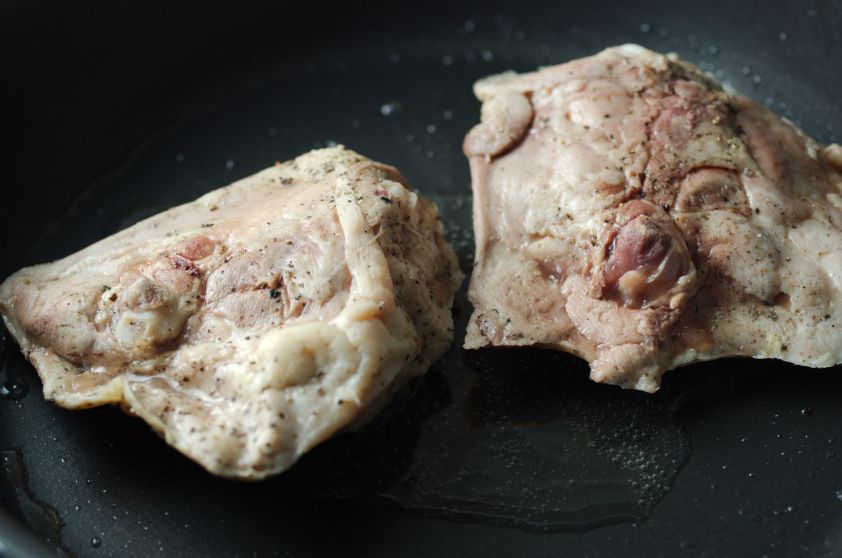
Voilà, au bout de 5 minutes, c’est sympathiquement doré. On passe l’autre côté une minute, et on réserve.
There, after 4 minutes it’s nicely browned. Heat the other side for another minute, and set it aside.

Pour la sauce, j’ai fait revenir un peu d’ail et d’oignon.
For the sauce, I put a bit of garlic and onion in the pan.
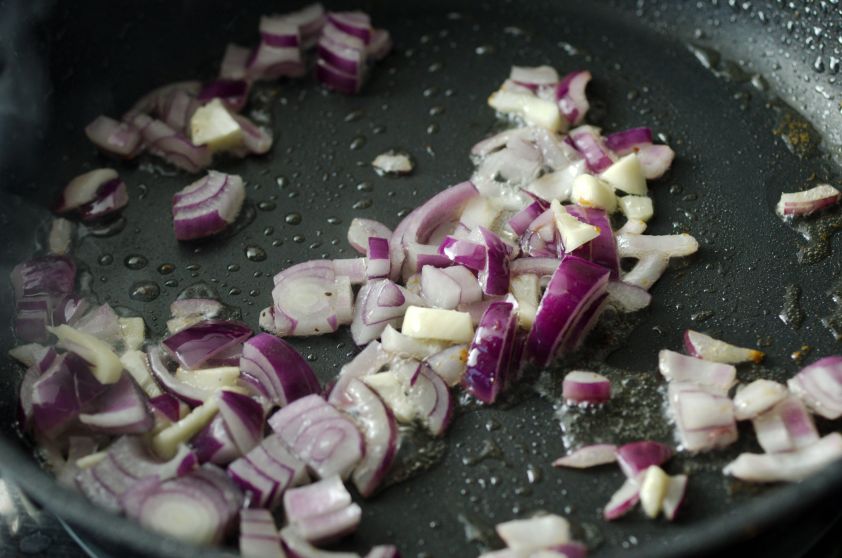
Un peu de cognac, la gelée réservée au moment de l’ouverture des sacs, un peu de moutarde. Et un peu de beurre pour finir la sauce.
A bit of cognac, the gelled liquid that I got from the bags, a bit of mustard. And a bit of butter to finish off the sauce.

Et voilà, le poulet avec des haricots verts et de la sauce 🙂
And there we go, chicken with green beans and sauce 🙂

Verdict : je confirme que le poulet ne sent PAS le réchauffé. Sans y être attentive, j’y suis relativement sensible, et là j’y étais attentive, donc je peux le dire avec une certaine certitude 🙂
Verdict: I can confirm that indeed, the chicken is devoid of re-heated taste. When I’m not paying particularly attention to it, I’m fairly sensitive to it; here, I was paying attention, so I can tell that with a certain amount of certainty 🙂
Est-ce que ça vaut le boulot supplémentaire par rapport à prendre le poulet et le coller au four et attendre qu’il soit cuit ? Je suis peut-être un peu plus réservée sur le sujet. Mais il faut admettre qu’à croustillant égal, le poulet cuit comme ça est plus juteux et plus goûtu (probablement parce qu’il ne surcuit pas), et que le fait d’avoir une base pour la sauce est plutôt chouette aussi. Je crois que j’essaierai à l’occasion SANS l’étape de refroidissement pour voir ce que ça donne, parce que pour le coup c’est le truc qui fait que c’est un peu pénible, faut prévoir plus tôt qu’une heure ou deux avant de manger.
Is it worth it compared to take the chicken, stuck it in the oven and wait for it to be cooked? I’m maybe a bit more dubious on that. But I have to admit that, for the same crispiness, the sous-vide chicken is juicier and tastier (probably because it doesn’t overcook), and the fact that you get a base for a sauce is pretty nice too. I think I’ll try WITHOUT the cooling phase some day to see how it compares, because that’s the thing that makes it a bit annoying, it needs to be planned earlier than an hour or two before the meal.
Tags recettes.de : poulet, sous-vide














